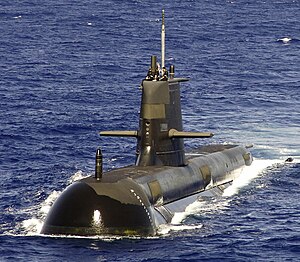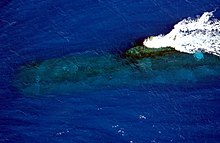HMAS Rankin
 From Wikipedia the free encyclopedia
From Wikipedia the free encyclopedia
 HMAS Rankin underway in 2006 | |
| History | |
|---|---|
| Name | Rankin |
| Namesake | Lieutenant Commander Robert Rankin |
| Builder | Australian Submarine Corporation |
| Laid down | 12 May 1995 |
| Launched | 7 November 2001 |
| Acquired | 18 March 2003 |
| Commissioned | 29 March 2003 |
| Homeport | Fleet Base West, Perth |
| Motto | "Defend the Weak" |
| Nickname(s) | The Black Knight |
| Status | Active as of 2016 |
| Badge |  |
| General characteristics | |
| Class and type | Collins-class submarine |
| Displacement |
|
| Length | 77.42 m (254.0 ft) |
| Beam | 7.8 m (26 ft) |
| Draught | 7 m (23 ft) at waterline |
| Installed power | 3 × Garden Island-Hedemora HV V18b/15Ub (VB210) 18-cylinder diesel motors, 3 × Jeumont-Schneider generators (1,400 kW, 440-volt DC) |
| Propulsion |
|
| Speed |
|
| Range |
|
| Endurance | 70 days |
| Test depth | Over 180 m (590 ft) (actual depth classified) |
| Complement |
|
| Sensors and processing systems |
|
| Armament |
|
| Notes | The sonars and combat system have been modernized since its entry into service |
HMAS Rankin is the sixth and final submarine of the Collins class, which are operated by the Royal Australian Navy (RAN). Named for Lieutenant Commander Robert William Rankin, the boat was laid down in 1995, and commissioned into the RAN in March 2003, following major delays.
Early in her career, Rankin was the subject of a documentary series and a coffee table book. She was the first submarine since 1987 to be awarded the Gloucester Cup.
Construction[edit]
Rankin was laid down by Australian Submarine Corporation on 12 May 1995.[1] The boat was launched on 7 November 2001.[2] She was delivered to the RAN on 18 March 2003 and commissioned on 29 March 2003, 41 months behind schedule, after major delays in the completion and fitting out of the boat due to the diversion of resources to the "fast track" submarines Dechaineux and Sheean and repeated cannibalisation for parts to repair the other five Collins-class boats.[3]
Rankin was named for Lieutenant Commander Robert William Rankin, who died when the ship he commanded, HMAS Yarra, engaged a force of five Japanese warships on 4 March 1942, to allow an Allied convoy to escape.[4] The boat is nicknamed "The Black Knight".[5]
Characteristics[edit]
The Collins class is an enlarged version of the Västergötland-class submarine designed by Kockums.[6] At 77.42 metres (254.0 ft) in length, with a beam of 7.8 metres (26 ft) and a waterline depth of 7 metres (23 ft), displacing 3,051 tonnes when surfaced, and 3,353 tonnes when submerged, they are the largest conventionally powered submarines in the world.[1][7] The hull is constructed from high-tensile micro-alloy steel, and are covered in a skin of anechoic tiles to minimise detection by sonar.[8][9] The depth that they can dive to is classified: most sources claim that it is over 180 metres (590 ft),[10][11]
The submarine is armed with six 21-inch (530 mm) torpedo tubes, and carry a standard payload of 22 torpedoes: originally a mix of Gould Mark 48 Mod 4 torpedoes and UGM-84C Sub-Harpoon, with the Mark 48s later upgraded to the Mod 7 Common Broadband Advanced Sonar System (CBASS) version.[1][12][13]
Each submarine is equipped with three Garden Island-Hedemora HV V18b/15Ub (VB210) 18-cylinder diesel engines, which are each connected to a 1,400 kW, 440-volt DC Jeumont-Schneider generator.[1][12] The electricity generated is stored in batteries, then supplied to a single Jeumont-Schneider DC motor, which provides 7,200 shaft horsepower to a single, seven-bladed, 4.22-metre (13.8 ft) diameter skewback propeller.[1][14] The Collins class has a speed of 10.5 knots (19.4 km/h; 12.1 mph) when surfaced and at snorkel depth, and can reach 21 knots (39 km/h; 24 mph) underwater.[1] The submarines have a range of 11,000 nautical miles (20,000 km; 13,000 mi) at 10 knots (19 km/h; 12 mph) when surfaced, 9,000 nautical miles (17,000 km; 10,000 mi) at 10 knots (19 km/h; 12 mph) at snorkel depth.[1] When submerged completely, a Collins class submarine can travel 32.6 nautical miles (60.4 km; 37.5 mi) at maximum speed, or 480 nautical miles (890 km; 550 mi) at 4 knots (7.4 km/h; 4.6 mph).[1] Each boat has a endurance of 70 days.[1]
Operational history[edit]
During a multinational exercise in September 2003, which was attended by Rankin and sister boat Waller, Rankin successfully "sank" a Singaporean anti-submarine warfare vessel.[15]

In 2004, a film crew was embarked aboard Rankin for the creation of Submariners, a six-part documentary aired by SBS in 2005 and depicting life aboard a submarine.[16] The film crew was on board from February to April 2004, during which the boat completed pre-deployment trials, participated in the submarine rescue exercise Pacific Reach, and made a diplomatic visit to Kure, Japan.[17] They later rejoined Rankin during the submarine's deployment to Hawaii for RIMPAC 04 in June and July.[18] Later that year, Rankin was also the subject of the book Beneath Southern Seas.[19] The coffee table book, which encompasses the history of the Royal Australian Navy Submarine Service, was primarily based on photographs and interviews of Rankin and those aboard taken by the authors during a twelve-day voyage from Sydney to Fremantle, concluding the six-month deployment started during the filming of Submariners.[19][20] The 20,000 nautical miles (37,000 km; 23,000 mi) voyage—the longest undertaken by a Collins-class submarine to that date—began with workups in February, and saw the submarine visit Korea, Japan, and Hawaii, and participate in various multinational exercises before returning to Fremantle via Sydney.[5] Rankin was at sea for 126 days, 80% of which was spent underwater.[5]
On 10 June 2005, Rankin was presented with the Gloucester Cup.[21] Presented to the RAN vessel with the greatest overall efficiency over the previous twelve months, Rankin was the first Collins-class submarine to earn the Cup, and the first submarine to receive it since Orion in 1987.[21] The award was again presented to Rankin in 2008.[22]
Rankin was docked for a long maintenance period in 2008, but workforce shortages and malfunctions on other submarines requiring urgent attention have drawn this out: in 2010 RAN and ASC officials predicted that she would not be back in service until 2013.[23] At the end of the works on Rankin, personnel were transferred from HMAS Farncomb (which was commencing a similar period of maintenance and upgrades), and Rankin arrived at Fleet Base West on 1 October 2014.[24]
Citations[edit]
- ^ a b c d e f g h i Wertheirm (ed.), Combat Fleets of the World, p. 18
- ^ Yule & Woolner, The Collins Class Submarine Story, p. 317
- ^ Yule & Woolner, The Collins Class Submarine Story, pp. 317–8, 348
- ^ Yule & Woolner, The Collins Class Submarine Story, p. 340
- ^ a b c Davidson & Allibone, Beneath Southern Seas, p. 133
- ^ Woolner, Procuring Change, p. 7
- ^ Jones, in The Royal Australian Navy, p. 244
- ^ Yule & Woolner, The Collins Class Submarine Story, pp. 165–74
- ^ ‘Built in Australia’ Collins rolls out, Jane's Defence Weekly
- ^ Wertheirm (ed.), Combat Fleets of the World, p. 19
- ^ Grazebrook, RAN prepares for Collins class
- ^ a b SSK Collins Class (Type 471) Attack Submarine, naval-technology.com
- ^ Heavyweight Torpedo – Mark 48, United States Navy Fact File
- ^ Grazebrook, Collins class comes up Down Under
- ^ Sherman Aussie Collins-Class Sub "Sinks" US Boat
- ^ Spencer, Wheeler, & Eccles, Submariners – making the TV series, p. 27
- ^ Spencer, Wheeler, & Eccles, Submariners – making the TV series, pp. 27–8
- ^ Spencer, Wheeler, & Eccles, Submariners – making the TV series, p. 28
- ^ a b Navy assists with launch of pictorial record of Australian Navy submarines [press release]
- ^ Davidson & Allibone, Beneath Southern Seas, pp. 121–4, 133
- ^ a b Davidson & Allibone, Beneath Southern Seas, p. 204
- ^ Jeffrey, Presentation of the 2007 Gloucester Cup to HMAS Rankin, [speech]
- ^ Oakes, Two subs out of action for 9 years
- ^ Casson, Neil (11 October 2014). "Rankin returns home". Navy Daily. Royal Australian Navy. Retrieved 11 October 2014.[permanent dead link]
References[edit]
- Books
- Davidson, Jon; Allibone, Tom (2005). Beneath Southern Seas. Crawley, WA: University of Western Australia Press. ISBN 1-920694-62-5. OCLC 69242056.
- Jones, Peter (2001). "A Period of Change and Uncertainty". In Stevens, David (ed.). The Royal Australian Navy. The Australian Centenary History of Defence. Vol. III. South Melbourne, VIC: Oxford University Press. ISBN 0-19-555542-2. OCLC 50418095.
- Wertheim, Eric, ed. (2007). The Naval Institute Guide to Combat Fleets of the World: Their Ships, Aircraft, and Systems (Google Books) (15th ed.). Annapolis, MD: Naval Institute Press. ISBN 978-1-59114-955-2. OCLC 140283156. Retrieved 1 May 2009.
- Yule, Peter; Woolner, Derek (2008). The Collins Class Submarine Story: Steel, Spies and Spin (Google Books). Port Melbourne, VIC: Cambridge University Press. ISBN 978-0-521-86894-5. OCLC 213111359. Retrieved 1 May 2009.
- Journal and news articles
- Grazebrook, A.W. (1 December 1995). "RAN prepares for Collins class". Jane's Navy International. 100 (6). Jane's Information Group.
- Grazebrook, A.W. (1 January 1998). "Collins class comes up Down Under". Jane's Navy International. 103 (1). Jane's Information Group.
- "'Built in Australia' Collins rolls out". Jane's Defence Weekly. 20 (6). Jane's Information Group. 7 August 1993.
- Oakes, Dan (11 February 2010). "Two subs out of action for 9 years". The Age. Retrieved 12 February 2010.
- Sherman, Kenneth B. (December 2003). "Aussie Collins-Class Sub "Sinks" US Boat". Journal of Electronic Defense. 26 (12): 24. ISSN 0192-429X.
- Spencer, Graham; Wheeler, Stu; Eccles, Nola. "Submariners – making the TV series". Sea Talk (Autumn 2005). Directorate of Defence Newspapers: 27–29. Retrieved 20 April 2009.
- Woolner, Derek (18 September 2001). "Procuring Change: How Kockums was Selected for the Collins Class Submarine" (PDF). Research Paper. 2001–02 (4). Canberra: Department of the Parliamentary Library. ISSN 1328-7478. Archived from the original (PDF) on 13 October 2010. Retrieved 24 April 2009.
- Other media
- Jeffery, Michael (8 April 2008). Presentation of the 2007 Gloucester Cup to HMAS Rankin (Speech). HMAS Stirling, WA. Archived from the original on 29 August 2009. Retrieved 26 May 2009.
- "Navy assists with launch of pictorial record of Australian Navy submarines" (Press release). Department of Defence. 16 December 2005. Retrieved 29 May 2009.
- "SSK Collins Class (Type 471) Attack Submarine". Industry Projects, naval-technology.com. SPG Media. Retrieved 20 April 2009.
External links[edit]
- Royal Australian Navy webpage for HMAS Rankin (SSG 78)
- Submariners Documentary site Archived 21 August 2006 at the Wayback Machine